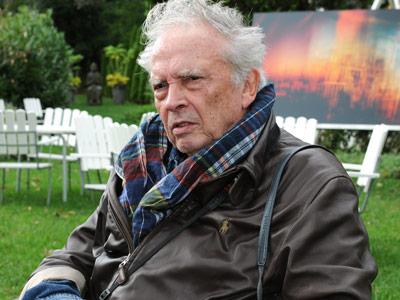David Bailey Shot Andy Warhol

It’s common knowledge that Andy Warhol was an enigma. David Bailey’s 1973 documentary mediation on him for the BBC, shown on Friday at the Hamptons International Film Festival, does not change that perception and yet it does manage to further our understanding of his world and reveals some glimpses of his humanity.
Undertaken at a time when his Pop Art icons were already firmly established in the art world, with their work then earning tens of thousands of dollars rather than the tens of millions now achieved at auction, “Warhol” is a look into Warhol’s role as filmmaker and his Factory studio Superstars, who played key roles in his life and his art.
One thing remains clear: The artist spent as much time crafting and maintaining his image as he did his art.
Mr. Bailey, a photographer and sometime filmmaker whose early life was the basis for the protagonist in the Michelangelo Antonioni film “Blow-Up,” was at the festival primarily to speak on a panel with Bruce Weber on Saturday night about his latest effort, a film called “Beaton by Bailey” on Cecil Beaton. Mr. Weber was in the audience at the Friday night screening and discussion, along with Calvin Klein, the clothing designer, art collector, and friend of Warhol.
Warhol had a long association with the South Fork and owned an estate in Montauk. The film was made prior to that, but parts were still captured here, with Warhol on the beach walking a dog and mounting a horse in his own unusual way. Mr. Bailey could not remember where the footage was taken, but in the film both Bailey and Warhol refer to visiting “Jane’s house.” Jane is presumably Jane Holzer, a Factory Superstar and friend of Warhol’s who at the time owned a Meadow Lane property in Southampton that Warhol was known to frequent.
Mr. Klein purchased the property a few years ago and leveled the castle-like structure that a later owner had erected and dubbed Dragon Head. Mr. Bailey photographed Ms. Holzer for British Vogue when she was modeling in the 1960s, which somehow completes the circle.
“Warhol” was a complex and expensive production, involving hours of film footage shot every day for three weeks and often with Warhol nowhere to be found. Mr. Bailey said he incorporated a stand-in to function as Warhol, citing sphinx-like aphorisms in his stead to save money and offer some content and context for his film. When Warhol was around, Mr. Bailey said interviewing him “was like shooting a bullet in silk” and he often said nothing.
Still, there are some moments where you catch the artist appearing to leave his shell, laughing or yawning at the actors making his films, and other little moments in which a glimmer of a real person shows through the mask.
There is an interlude in a car on the way to the beach during which Mr. Bailey is driving and Warhol is seated way too close to him even though the front seat is otherwise empty. The discussion there is mostly about why he chose to sit in the middle, which was to avoid being hurt in a car crash, a subject he knew much about from his own artistic explorations of it.
He said the car crash victims struck him in the same wayhe thought about unnamed people who invented buttons or who worked on the pyramids in Egypt. It seemed easier to capture this idea in “painting the people who die in car crashes, because you never know who they are.” As ludicrous as this sounds, his delivery of it feels true, and why not? He also offered that he stopped painting because “I bought a camera and a camera seemed so much easier.”
Other more personal moments in the film come near the end, when the artist and the filmmaker are talking in bed together. “We went to bed, but it was a joke,” Mr. Bailey said. “He said, if you go to bed with me, I’ll make the film.” Warhol is fully clothed, at least on top. He tells the filmmaker that he is self-conscious about his chest because of the scars he had from bullet wounds. Five years prior to the filming in 1968, Warhol was shot by Valerie Solanas, an acquaintance of his who was angry because he would not produce her screenplay.
There are recollections by Factory regulars of the shooting, of Warhol pleading with her to stop, and his recovery. He described his chest as an “Yves St. Laurent dress, it’s all stitches,” but said the only thing that changed as a result of the shooting is that he didn’t take off his clothes after it. Others in the film said he was gentler because of it.
Although made for British television, the piece still caused a controversy in its time. Mr. Bailey noted, “They had to change the law to show it.” One reason was that the film surpassed the allowable limit of three instances of the F-word.
The other reason was a segment with Brigid Berlin, one of the stars of Warhol’s films and an actual Factory employee who sat at the front desk and transcribed interviews. She was also known for her Yves Klein-like creations in which she would apply paint to her breasts and press them to canvas, something she does in the film while she speaks to Warhol on the phone. “It got banned,” he said in his Cockney accent, “because Brigid painted with her titties.”
